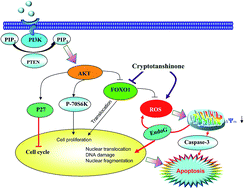Cryptotanshinone inhibits proliferation and induces apoptosis via mitochondria-derived reactive oxygen species involving FOXO1 in estrogen receptor-negative breast cancer Bcap37 cells
Abstract
Cryptotanshinone is a natural abietane type-diterpene quinine isolated from the lipophilic extract of Tanshen (or Danshen, Salvia miltiorrhiza Bunge) which is widely used in clinical applications for treating inflammations such as acne, tonsillitis and mastitis at present. Previous studies indicated that cryptotanshinone could not only inhibit the growth of androgen dependent and castration resistant prostate cancer cells by suppressing the androgen receptor (AR), but also inhibit estrogen receptor (ER)-positive breast cancer cell proliferation by suppressing ER signals. In this work, we found cryptotanshinone can effectively inhibit the proliferation of ER-negative breast cancer Bcap37 cells. Cryptotanshinone induced mitochondria-mediated apoptosis through changes in nuclear morphology, DNA fragmentation, loss of mitochondrial membrane potential, activation of caspase-like activities and translocation of endonuclease G (EndoG) from mitochondria into nucleus. During the process, the caspases inhibitor could not completely abrogate apoptosis caused by cryptotanshinone, suggesting that the intrinsic caspase-independent signaling functioned was one of the major pathways under high stress of cryptotanshinone. In addition, the apoptosis involved several key signals of cell proliferation and ROS regulation, such as suppression of PTEN and up-regulation of phosphorylated-AKT (Ser 473), thus the expression of a key transcription factor FOXO1 was down-regulated further and resulted in accumulation of ROS that brought about the following oxidative DNA damage. In summary, the results showed that cryptotanshinone might be a promising apoptosis-inducing agent in the treatment of ER-negative breast cancers by activation of mitochondria-derived ROS/FOXO1 signaling pathways.


 Please wait while we load your content...
Please wait while we load your content...